CHAPTER 4: FINANCIAL MARKETS 4-1 The Demand for
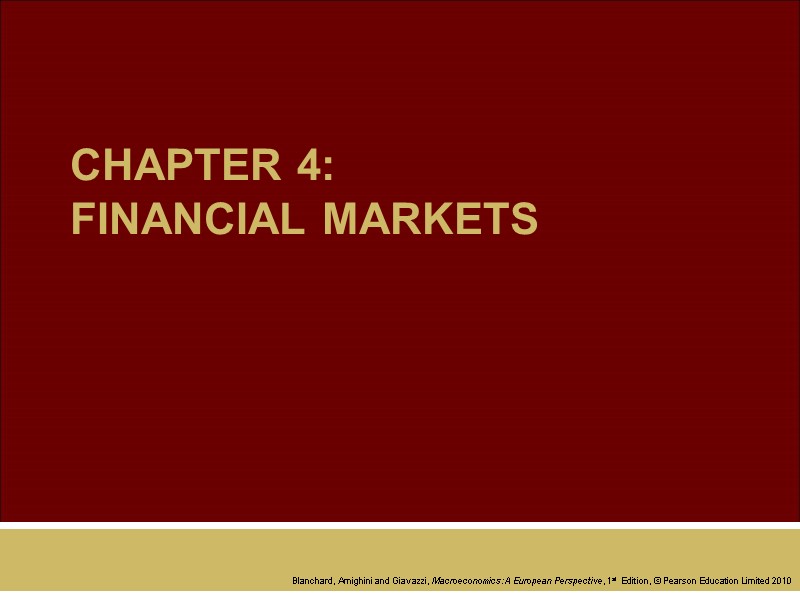
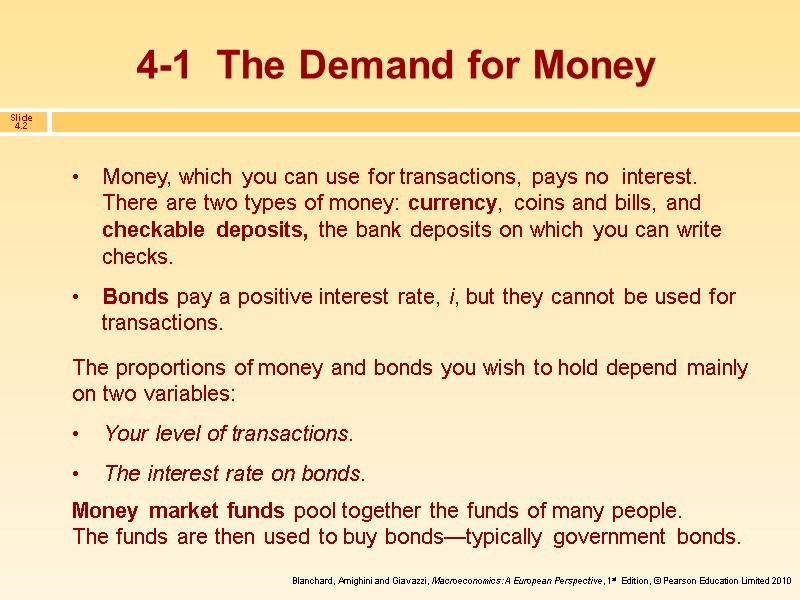
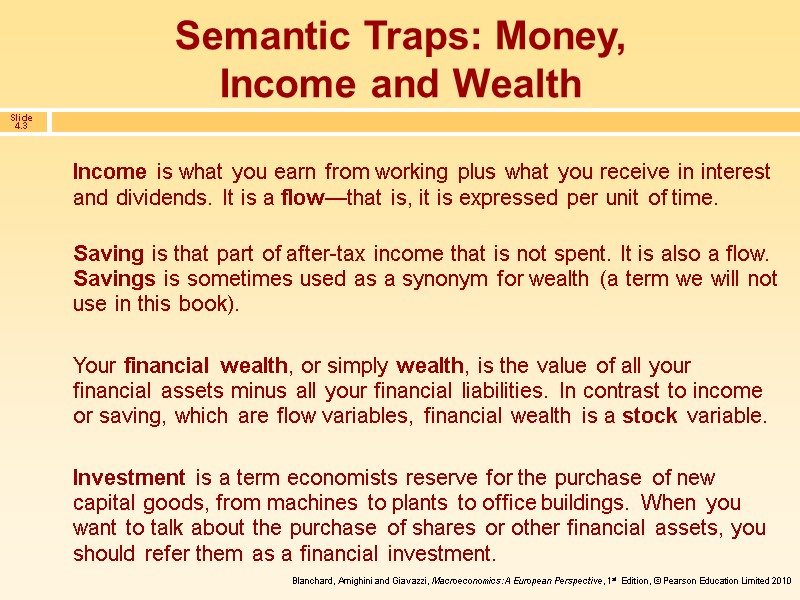
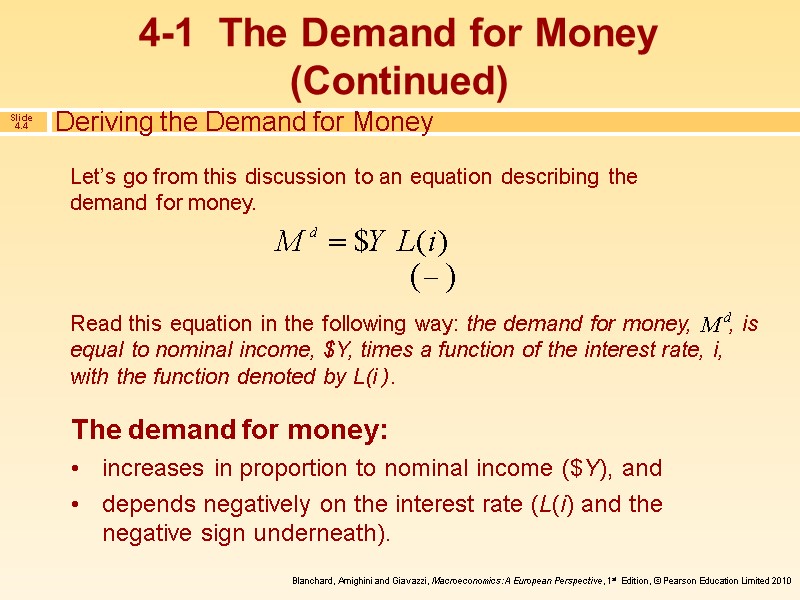
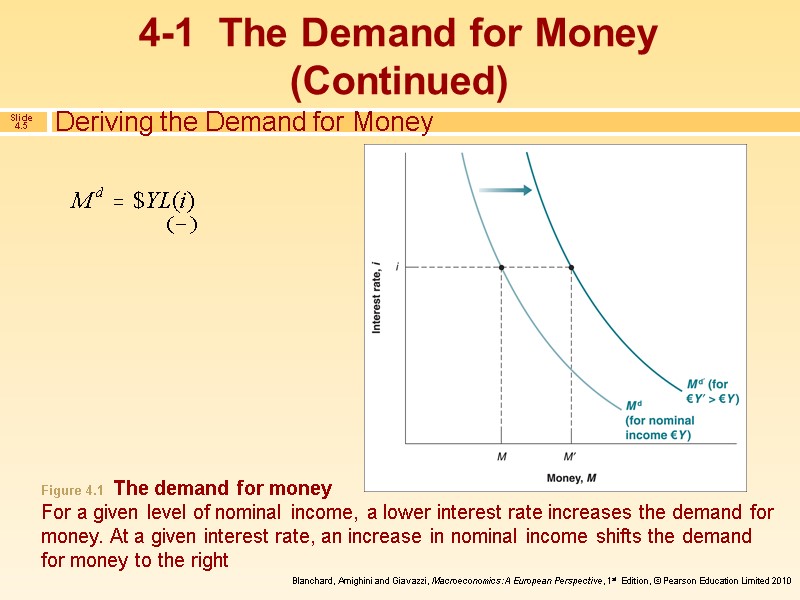
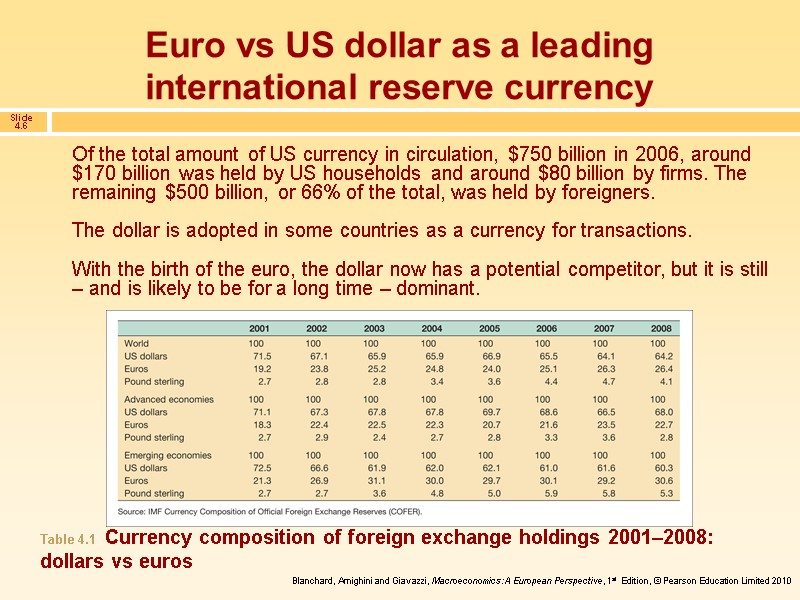
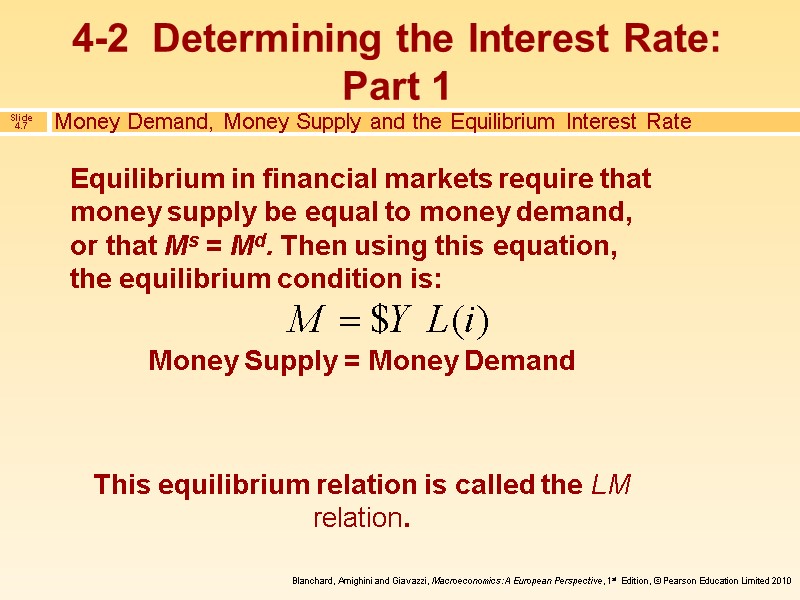
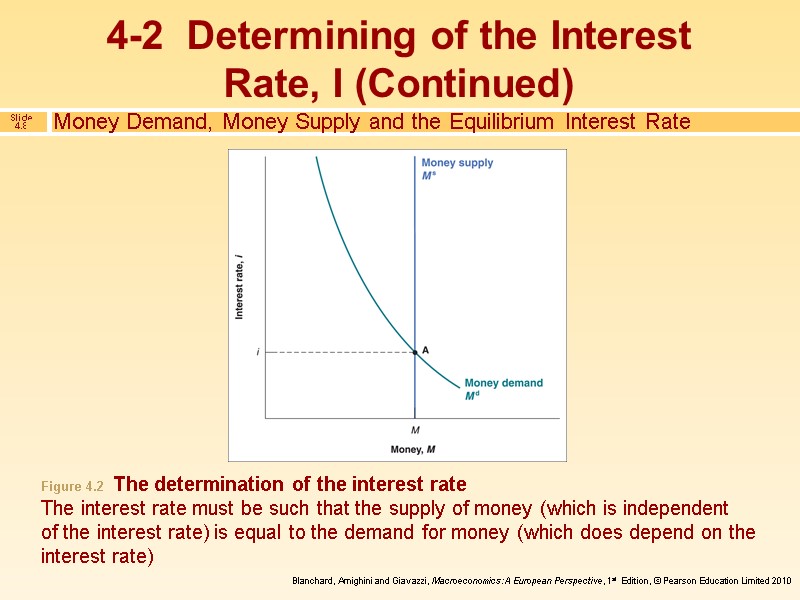
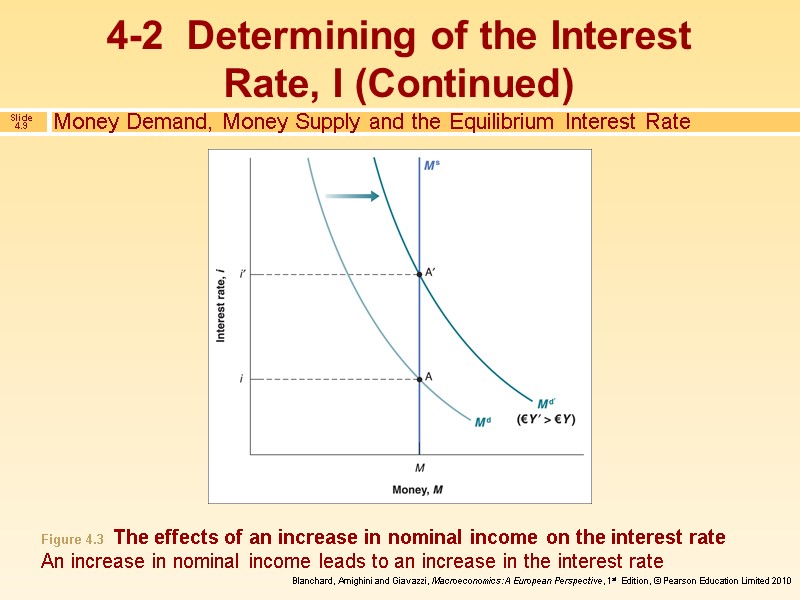
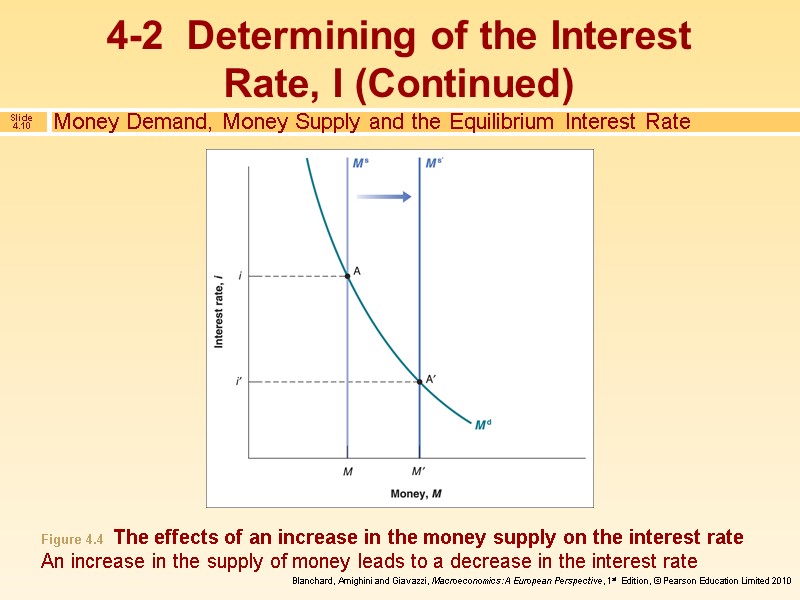
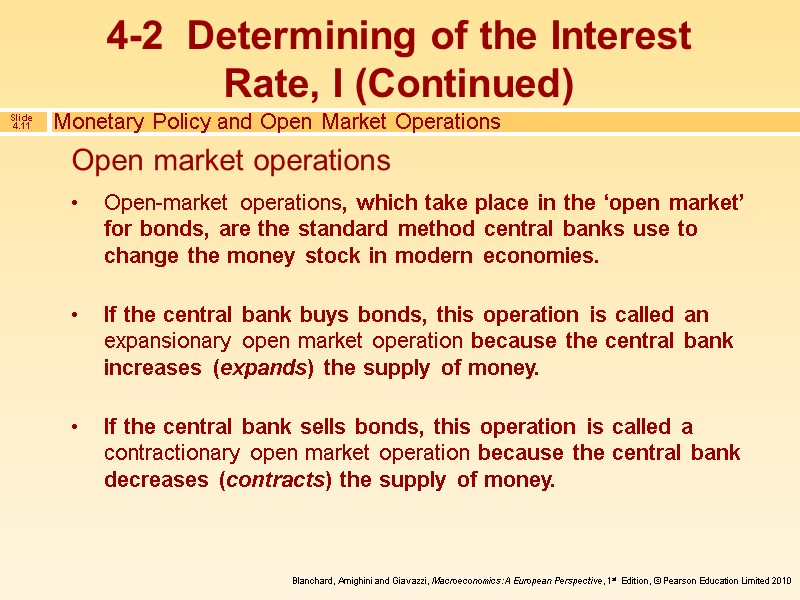
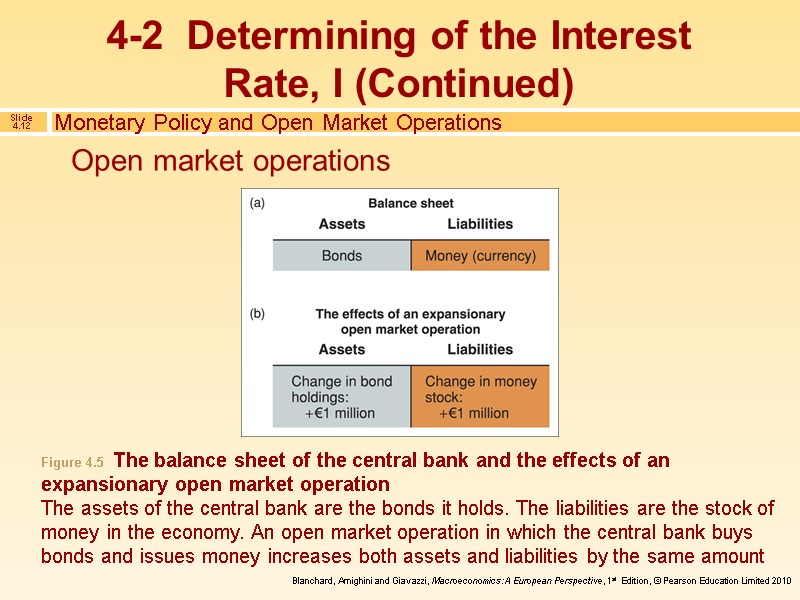
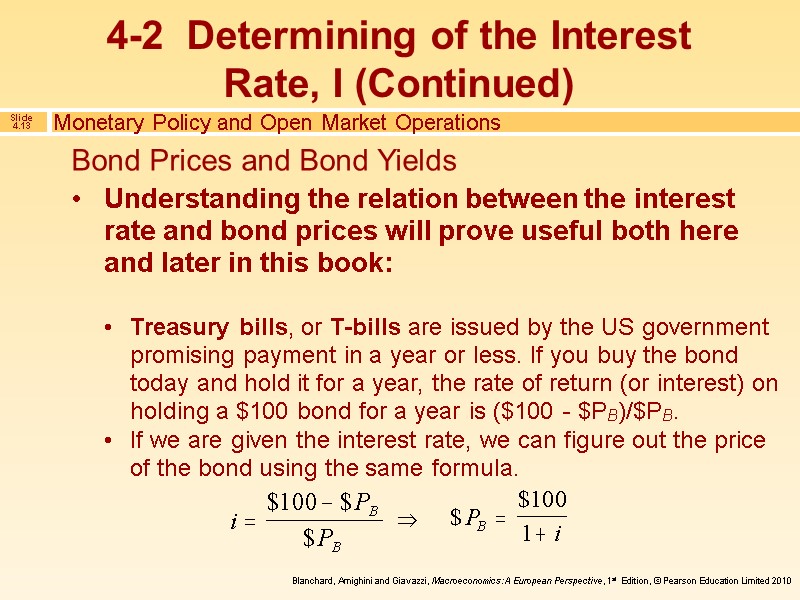
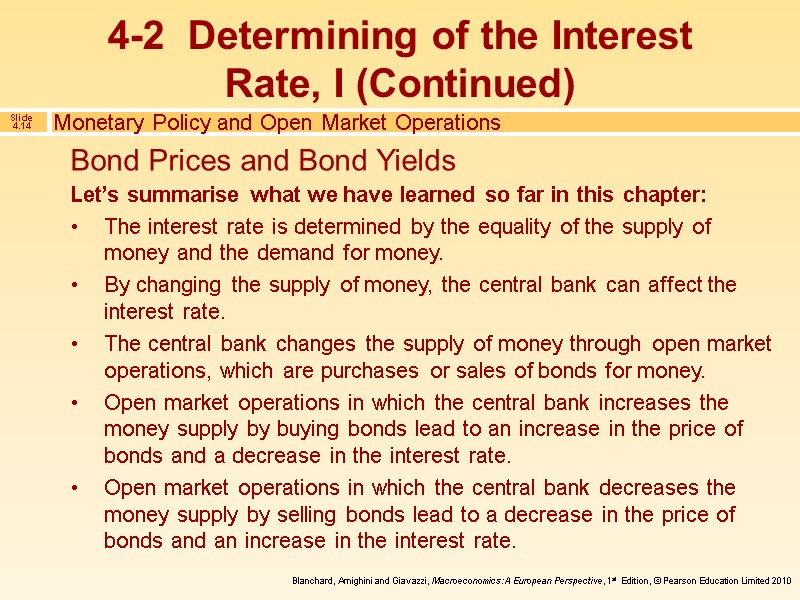
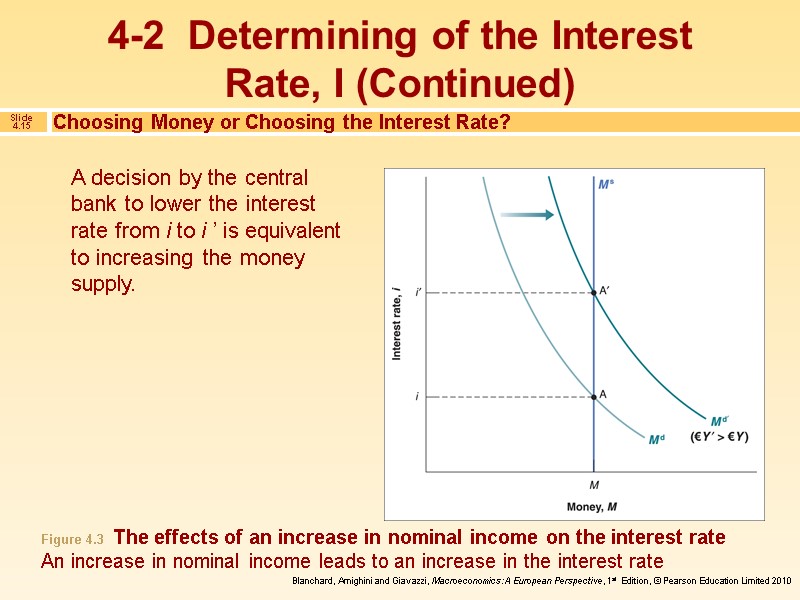
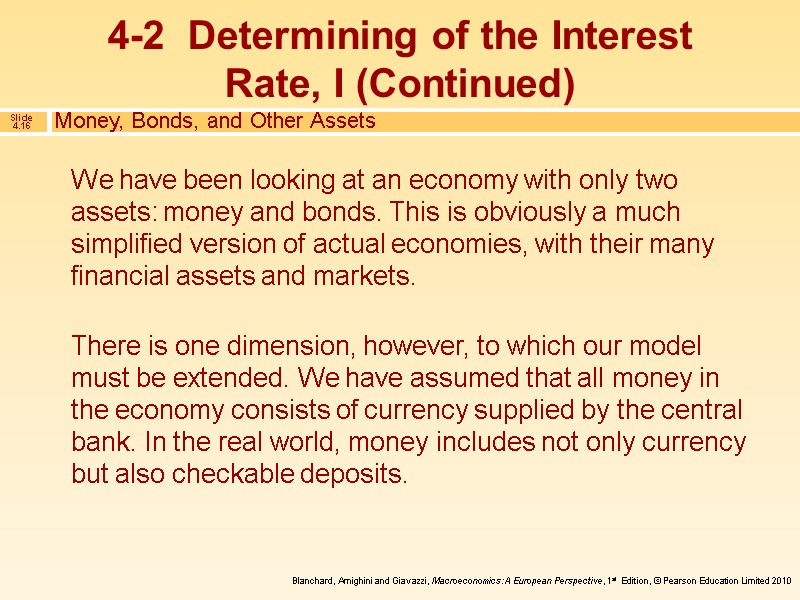
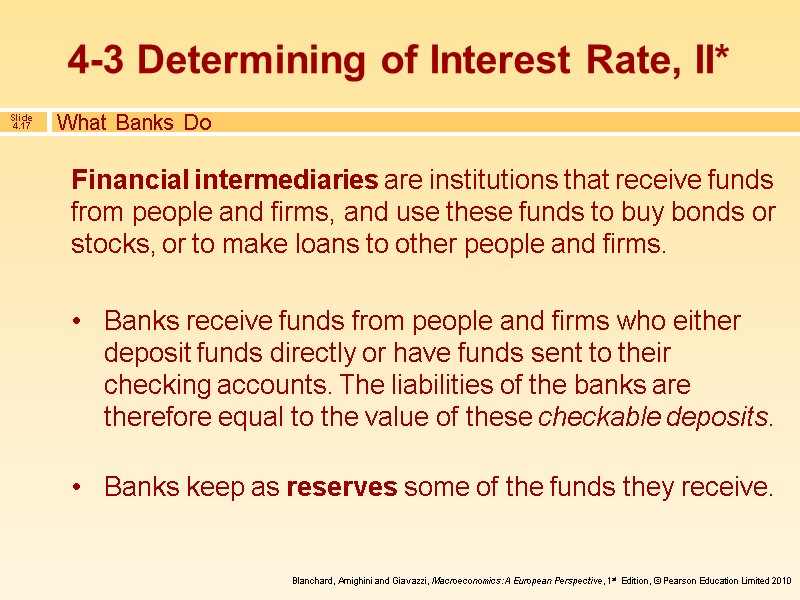
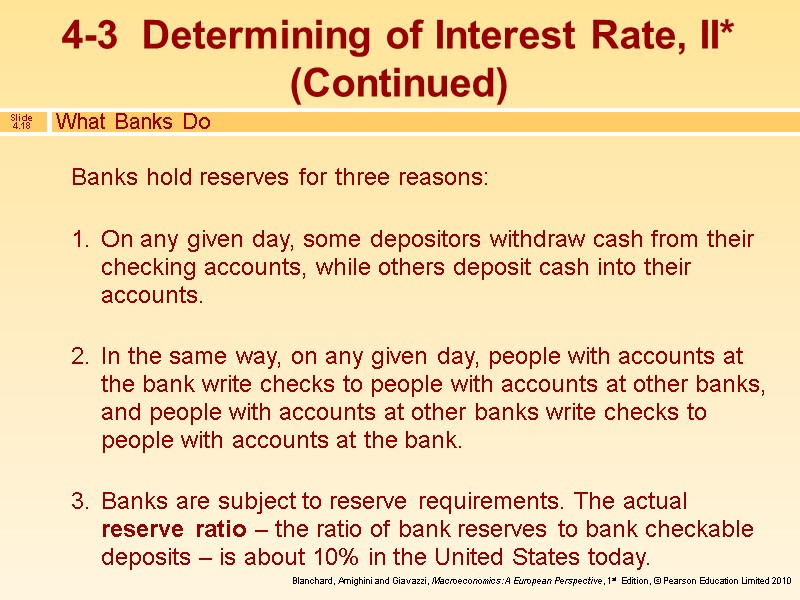
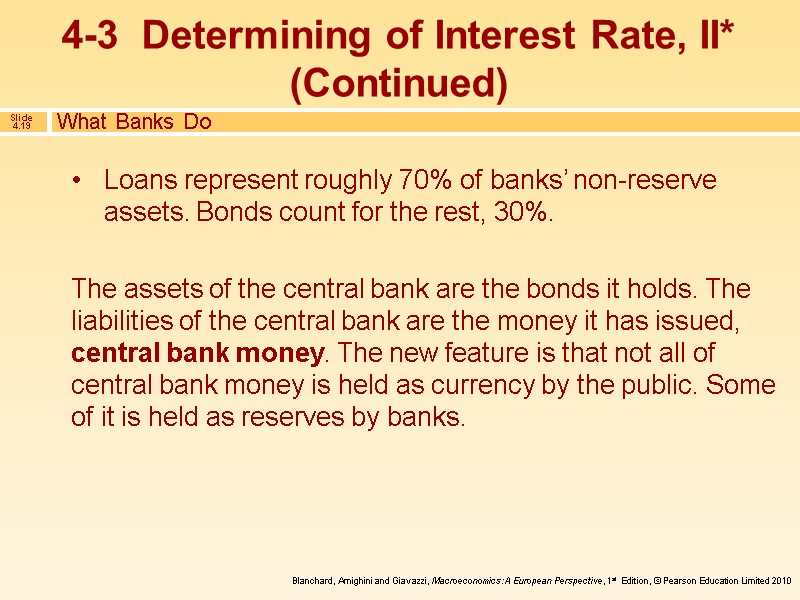
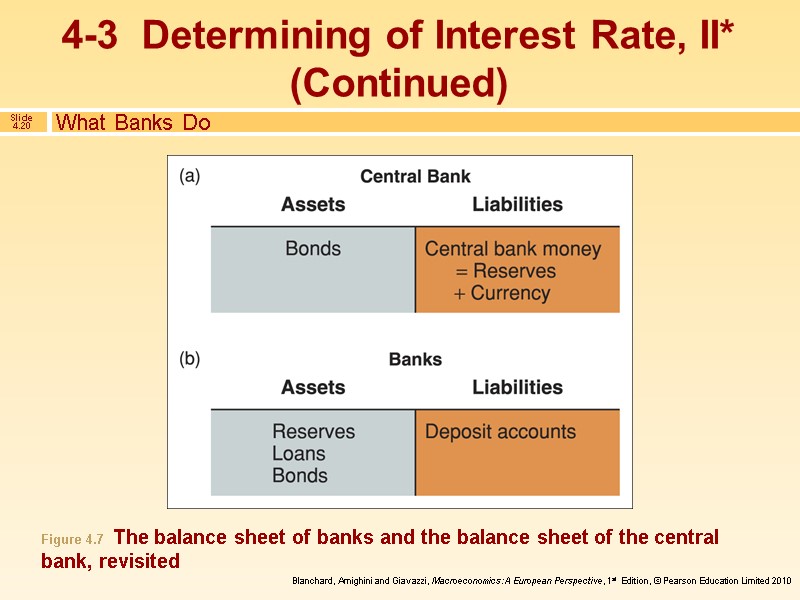
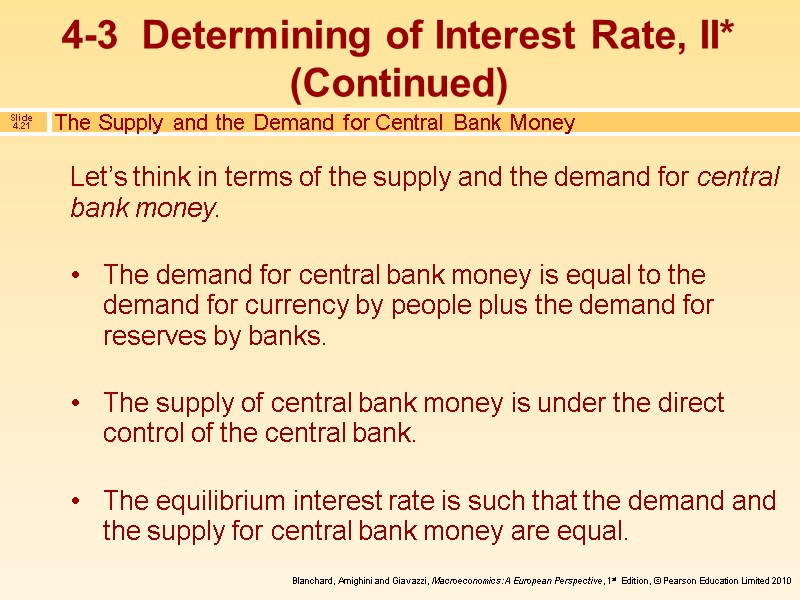
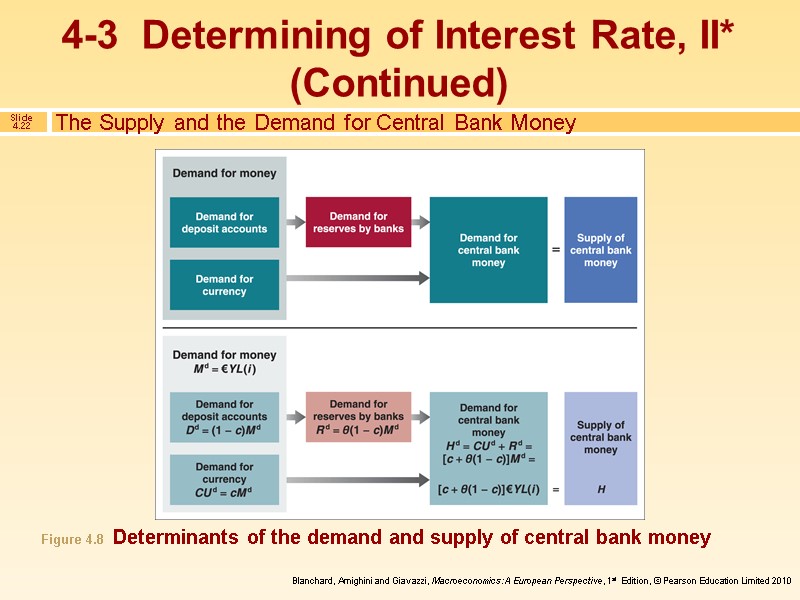
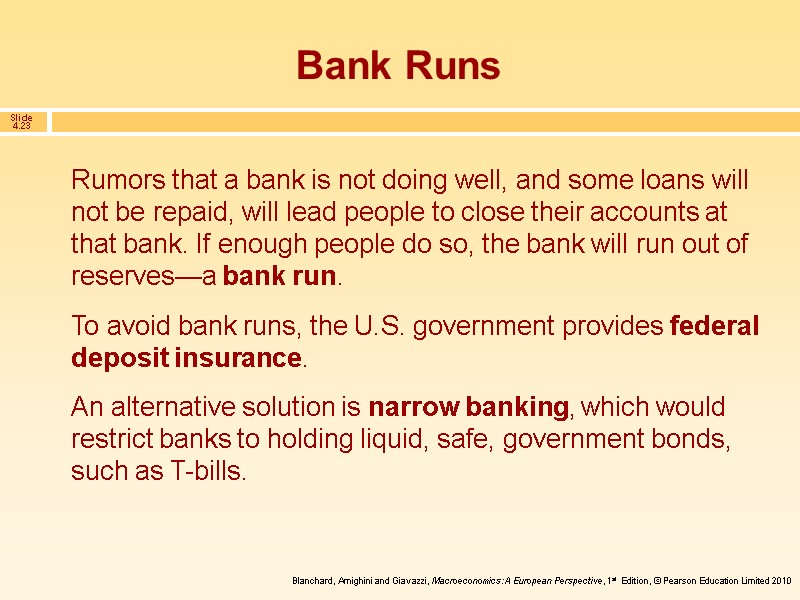
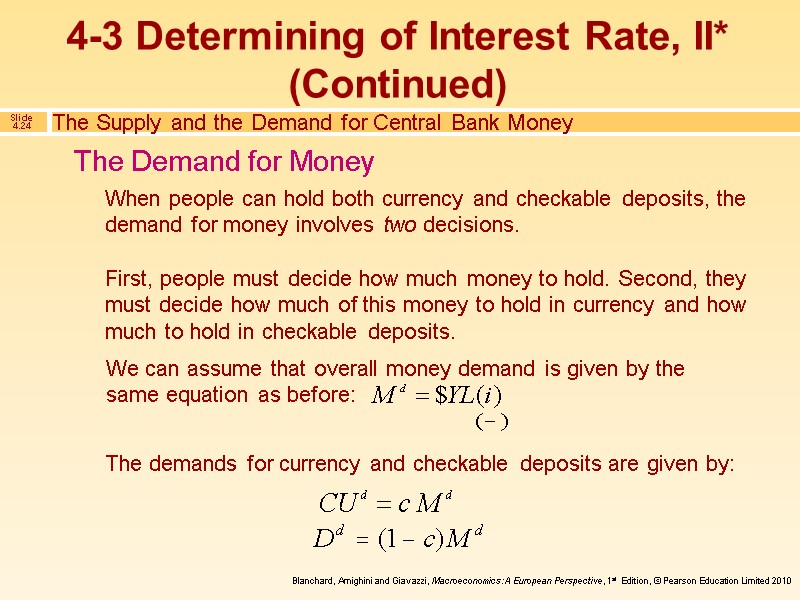
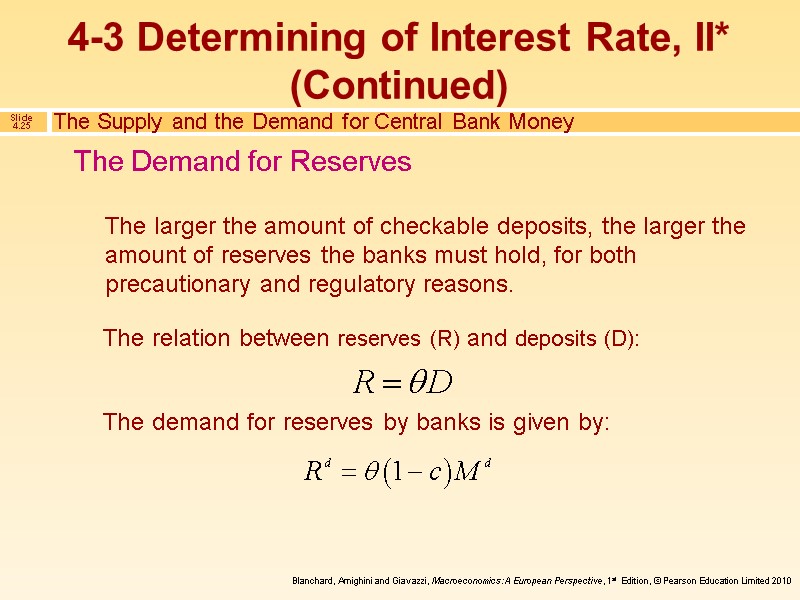
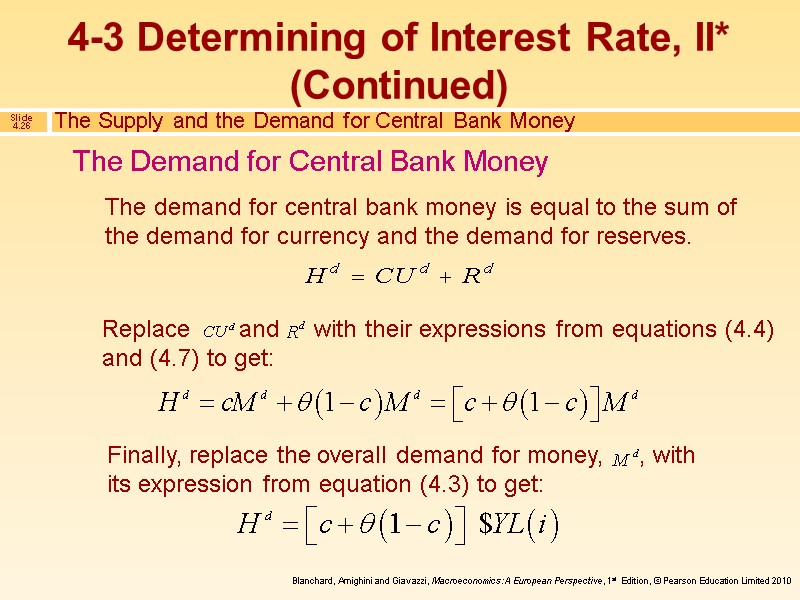
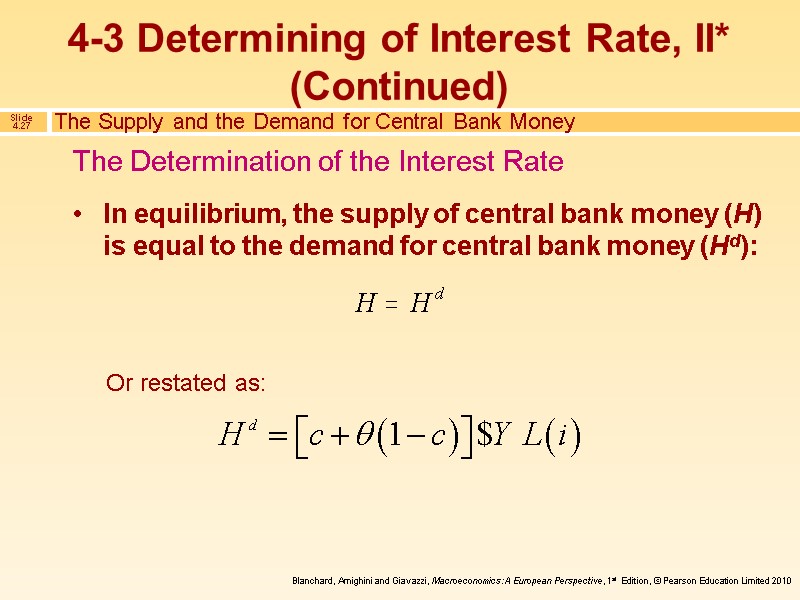
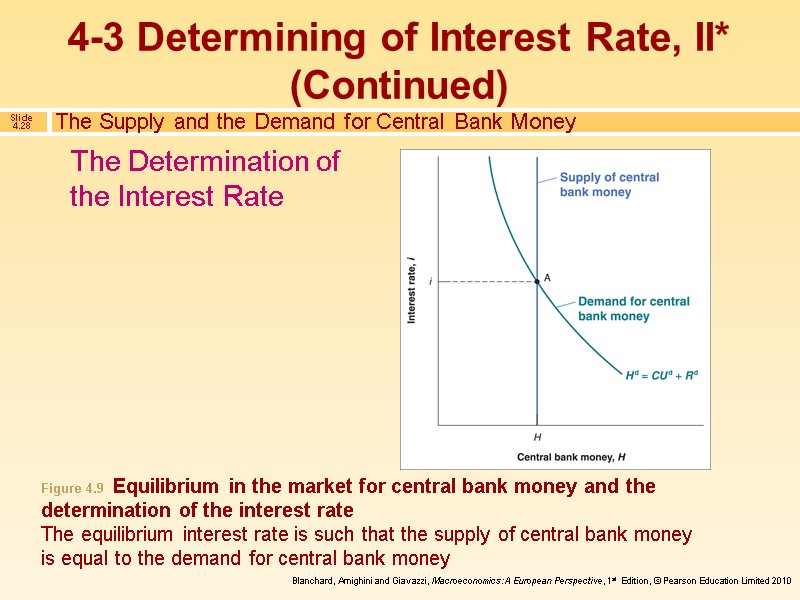
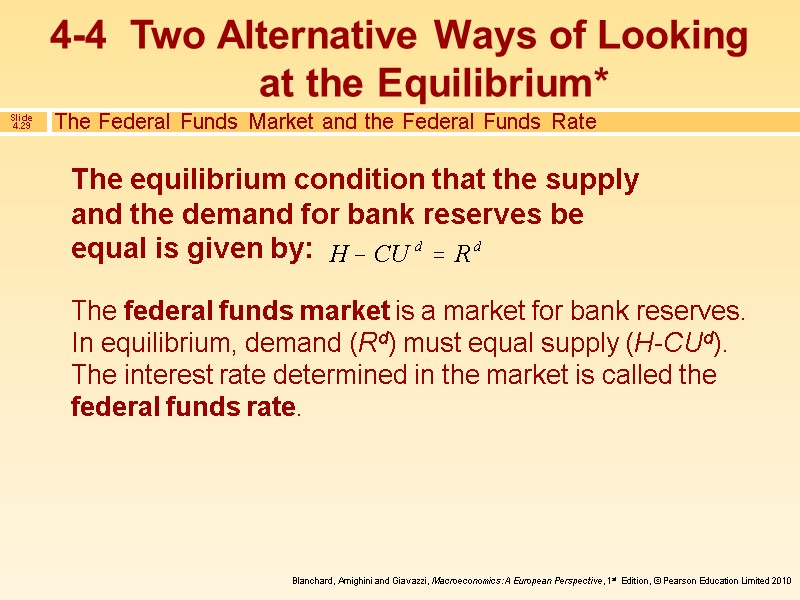
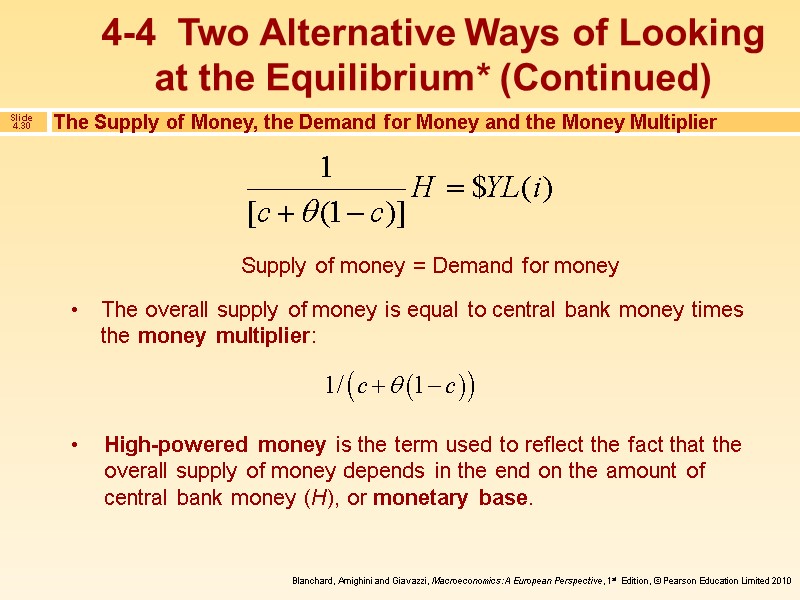
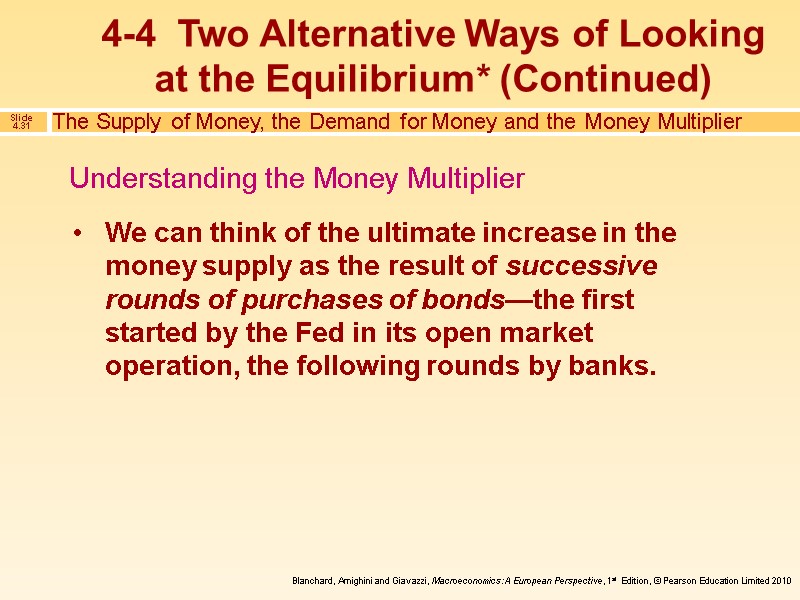
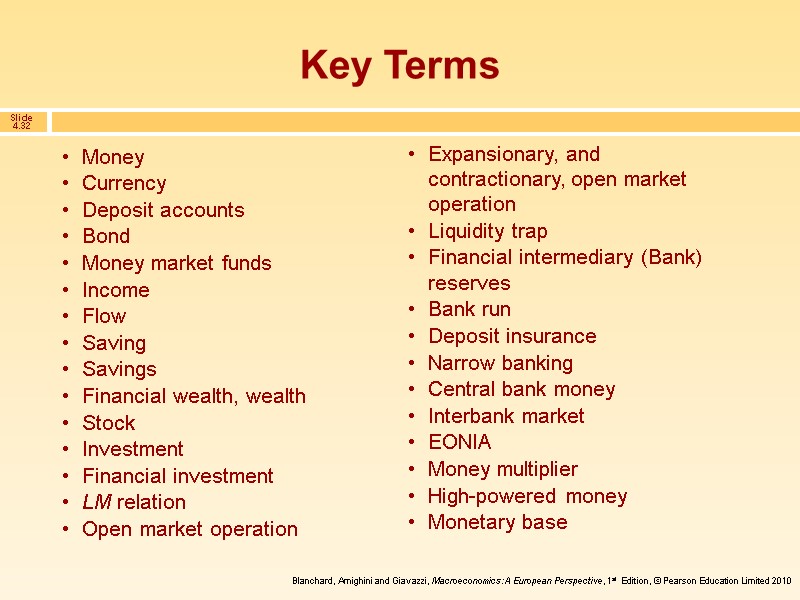
37540-blanchard__-_macroeconomics__-_chapter_4.ppt
- Количество слайдов: 32
 CHAPTER 4: FINANCIAL MARKETS
CHAPTER 4: FINANCIAL MARKETS
 4-1 The Demand for Money Money, which you can use for transactions, pays no interest. There are two types of money: currency, coins and bills, and checkable deposits, the bank deposits on which you can write checks. Bonds pay a positive interest rate, i, but they cannot be used for transactions. The proportions of money and bonds you wish to hold depend mainly on two variables: Your level of transactions. The interest rate on bonds. Money market funds pool together the funds of many people. The funds are then used to buy bonds—typically government bonds.
4-1 The Demand for Money Money, which you can use for transactions, pays no interest. There are two types of money: currency, coins and bills, and checkable deposits, the bank deposits on which you can write checks. Bonds pay a positive interest rate, i, but they cannot be used for transactions. The proportions of money and bonds you wish to hold depend mainly on two variables: Your level of transactions. The interest rate on bonds. Money market funds pool together the funds of many people. The funds are then used to buy bonds—typically government bonds.
 Semantic Traps: Money, Income and Wealth Income is what you earn from working plus what you receive in interest and dividends. It is a flow—that is, it is expressed per unit of time. Saving is that part of after-tax income that is not spent. It is also a flow. Savings is sometimes used as a synonym for wealth (a term we will not use in this book). Your financial wealth, or simply wealth, is the value of all your financial assets minus all your financial liabilities. In contrast to income or saving, which are flow variables, financial wealth is a stock variable. Investment is a term economists reserve for the purchase of new capital goods, from machines to plants to office buildings. When you want to talk about the purchase of shares or other financial assets, you should refer them as a financial investment.
Semantic Traps: Money, Income and Wealth Income is what you earn from working plus what you receive in interest and dividends. It is a flow—that is, it is expressed per unit of time. Saving is that part of after-tax income that is not spent. It is also a flow. Savings is sometimes used as a synonym for wealth (a term we will not use in this book). Your financial wealth, or simply wealth, is the value of all your financial assets minus all your financial liabilities. In contrast to income or saving, which are flow variables, financial wealth is a stock variable. Investment is a term economists reserve for the purchase of new capital goods, from machines to plants to office buildings. When you want to talk about the purchase of shares or other financial assets, you should refer them as a financial investment.
 4-1 The Demand for Money (Continued) Let’s go from this discussion to an equation describing the demand for money. Read this equation in the following way: the demand for money, , is equal to nominal income, $Y, times a function of the interest rate, i, with the function denoted by L(i ). Deriving the Demand for Money The demand for money: increases in proportion to nominal income ($Y), and depends negatively on the interest rate (L(i) and the negative sign underneath).
4-1 The Demand for Money (Continued) Let’s go from this discussion to an equation describing the demand for money. Read this equation in the following way: the demand for money, , is equal to nominal income, $Y, times a function of the interest rate, i, with the function denoted by L(i ). Deriving the Demand for Money The demand for money: increases in proportion to nominal income ($Y), and depends negatively on the interest rate (L(i) and the negative sign underneath).
 Deriving the Demand for Money Figure 4.1 The demand for money For a given level of nominal income, a lower interest rate increases the demand for money. At a given interest rate, an increase in nominal income shifts the demand for money to the right 4-1 The Demand for Money (Continued)
Deriving the Demand for Money Figure 4.1 The demand for money For a given level of nominal income, a lower interest rate increases the demand for money. At a given interest rate, an increase in nominal income shifts the demand for money to the right 4-1 The Demand for Money (Continued)
 Euro vs US dollar as a leading international reserve currency Of the total amount of US currency in circulation, $750 billion in 2006, around $170 billion was held by US households and around $80 billion by firms. The remaining $500 billion, or 66% of the total, was held by foreigners. The dollar is adopted in some countries as a currency for transactions. With the birth of the euro, the dollar now has a potential competitor, but it is still – and is likely to be for a long time – dominant. Table 4.1 Currency composition of foreign exchange holdings 2001–2008: dollars vs euros
Euro vs US dollar as a leading international reserve currency Of the total amount of US currency in circulation, $750 billion in 2006, around $170 billion was held by US households and around $80 billion by firms. The remaining $500 billion, or 66% of the total, was held by foreigners. The dollar is adopted in some countries as a currency for transactions. With the birth of the euro, the dollar now has a potential competitor, but it is still – and is likely to be for a long time – dominant. Table 4.1 Currency composition of foreign exchange holdings 2001–2008: dollars vs euros
 4-2 Determining the Interest Rate: Part 1 Money Demand, Money Supply and the Equilibrium Interest Rate Equilibrium in financial markets require that money supply be equal to money demand, or that Ms = Md. Then using this equation, the equilibrium condition is: Money Supply = Money Demand This equilibrium relation is called the LM relation.
4-2 Determining the Interest Rate: Part 1 Money Demand, Money Supply and the Equilibrium Interest Rate Equilibrium in financial markets require that money supply be equal to money demand, or that Ms = Md. Then using this equation, the equilibrium condition is: Money Supply = Money Demand This equilibrium relation is called the LM relation.
 4-2 Determining of the Interest Rate, I (Continued) Money Demand, Money Supply and the Equilibrium Interest Rate Figure 4.2 The determination of the interest rate The interest rate must be such that the supply of money (which is independent of the interest rate) is equal to the demand for money (which does depend on the interest rate)
4-2 Determining of the Interest Rate, I (Continued) Money Demand, Money Supply and the Equilibrium Interest Rate Figure 4.2 The determination of the interest rate The interest rate must be such that the supply of money (which is independent of the interest rate) is equal to the demand for money (which does depend on the interest rate)
 Money Demand, Money Supply and the Equilibrium Interest Rate Figure 4.3 The effects of an increase in nominal income on the interest rate An increase in nominal income leads to an increase in the interest rate 4-2 Determining of the Interest Rate, I (Continued)
Money Demand, Money Supply and the Equilibrium Interest Rate Figure 4.3 The effects of an increase in nominal income on the interest rate An increase in nominal income leads to an increase in the interest rate 4-2 Determining of the Interest Rate, I (Continued)
 Money Demand, Money Supply and the Equilibrium Interest Rate Figure 4.4 The effects of an increase in the money supply on the interest rate An increase in the supply of money leads to a decrease in the interest rate 4-2 Determining of the Interest Rate, I (Continued)
Money Demand, Money Supply and the Equilibrium Interest Rate Figure 4.4 The effects of an increase in the money supply on the interest rate An increase in the supply of money leads to a decrease in the interest rate 4-2 Determining of the Interest Rate, I (Continued)
 Monetary Policy and Open Market Operations Open-market operations, which take place in the ‘open market’ for bonds, are the standard method central banks use to change the money stock in modern economies. If the central bank buys bonds, this operation is called an expansionary open market operation because the central bank increases (expands) the supply of money. If the central bank sells bonds, this operation is called a contractionary open market operation because the central bank decreases (contracts) the supply of money. Open market operations 4-2 Determining of the Interest Rate, I (Continued)
Monetary Policy and Open Market Operations Open-market operations, which take place in the ‘open market’ for bonds, are the standard method central banks use to change the money stock in modern economies. If the central bank buys bonds, this operation is called an expansionary open market operation because the central bank increases (expands) the supply of money. If the central bank sells bonds, this operation is called a contractionary open market operation because the central bank decreases (contracts) the supply of money. Open market operations 4-2 Determining of the Interest Rate, I (Continued)
 Open market operations Monetary Policy and Open Market Operations Figure 4.5 The balance sheet of the central bank and the effects of an expansionary open market operation The assets of the central bank are the bonds it holds. The liabilities are the stock of money in the economy. An open market operation in which the central bank buys bonds and issues money increases both assets and liabilities by the same amount 4-2 Determining of the Interest Rate, I (Continued)
Open market operations Monetary Policy and Open Market Operations Figure 4.5 The balance sheet of the central bank and the effects of an expansionary open market operation The assets of the central bank are the bonds it holds. The liabilities are the stock of money in the economy. An open market operation in which the central bank buys bonds and issues money increases both assets and liabilities by the same amount 4-2 Determining of the Interest Rate, I (Continued)
 Understanding the relation between the interest rate and bond prices will prove useful both here and later in this book: Treasury bills, or T-bills are issued by the US government promising payment in a year or less. If you buy the bond today and hold it for a year, the rate of return (or interest) on holding a $100 bond for a year is ($100 - $PB)/$PB. If we are given the interest rate, we can figure out the price of the bond using the same formula. Bond Prices and Bond Yields Monetary Policy and Open Market Operations 4-2 Determining of the Interest Rate, I (Continued)
Understanding the relation between the interest rate and bond prices will prove useful both here and later in this book: Treasury bills, or T-bills are issued by the US government promising payment in a year or less. If you buy the bond today and hold it for a year, the rate of return (or interest) on holding a $100 bond for a year is ($100 - $PB)/$PB. If we are given the interest rate, we can figure out the price of the bond using the same formula. Bond Prices and Bond Yields Monetary Policy and Open Market Operations 4-2 Determining of the Interest Rate, I (Continued)
 Let’s summarise what we have learned so far in this chapter: The interest rate is determined by the equality of the supply of money and the demand for money. By changing the supply of money, the central bank can affect the interest rate. The central bank changes the supply of money through open market operations, which are purchases or sales of bonds for money. Open market operations in which the central bank increases the money supply by buying bonds lead to an increase in the price of bonds and a decrease in the interest rate. Open market operations in which the central bank decreases the money supply by selling bonds lead to a decrease in the price of bonds and an increase in the interest rate. Bond Prices and Bond Yields Monetary Policy and Open Market Operations 4-2 Determining of the Interest Rate, I (Continued)
Let’s summarise what we have learned so far in this chapter: The interest rate is determined by the equality of the supply of money and the demand for money. By changing the supply of money, the central bank can affect the interest rate. The central bank changes the supply of money through open market operations, which are purchases or sales of bonds for money. Open market operations in which the central bank increases the money supply by buying bonds lead to an increase in the price of bonds and a decrease in the interest rate. Open market operations in which the central bank decreases the money supply by selling bonds lead to a decrease in the price of bonds and an increase in the interest rate. Bond Prices and Bond Yields Monetary Policy and Open Market Operations 4-2 Determining of the Interest Rate, I (Continued)
 A decision by the central bank to lower the interest rate from i to i ’ is equivalent to increasing the money supply. Choosing Money or Choosing the Interest Rate? Figure 4.3 The effects of an increase in nominal income on the interest rate An increase in nominal income leads to an increase in the interest rate 4-2 Determining of the Interest Rate, I (Continued)
A decision by the central bank to lower the interest rate from i to i ’ is equivalent to increasing the money supply. Choosing Money or Choosing the Interest Rate? Figure 4.3 The effects of an increase in nominal income on the interest rate An increase in nominal income leads to an increase in the interest rate 4-2 Determining of the Interest Rate, I (Continued)
 We have been looking at an economy with only two assets: money and bonds. This is obviously a much simplified version of actual economies, with their many financial assets and markets. There is one dimension, however, to which our model must be extended. We have assumed that all money in the economy consists of currency supplied by the central bank. In the real world, money includes not only currency but also checkable deposits. Money, Bonds, and Other Assets 4-2 Determining of the Interest Rate, I (Continued)
We have been looking at an economy with only two assets: money and bonds. This is obviously a much simplified version of actual economies, with their many financial assets and markets. There is one dimension, however, to which our model must be extended. We have assumed that all money in the economy consists of currency supplied by the central bank. In the real world, money includes not only currency but also checkable deposits. Money, Bonds, and Other Assets 4-2 Determining of the Interest Rate, I (Continued)
 4-3 Determining of Interest Rate, II* Financial intermediaries are institutions that receive funds from people and firms, and use these funds to buy bonds or stocks, or to make loans to other people and firms. Banks receive funds from people and firms who either deposit funds directly or have funds sent to their checking accounts. The liabilities of the banks are therefore equal to the value of these checkable deposits. Banks keep as reserves some of the funds they receive. What Banks Do
4-3 Determining of Interest Rate, II* Financial intermediaries are institutions that receive funds from people and firms, and use these funds to buy bonds or stocks, or to make loans to other people and firms. Banks receive funds from people and firms who either deposit funds directly or have funds sent to their checking accounts. The liabilities of the banks are therefore equal to the value of these checkable deposits. Banks keep as reserves some of the funds they receive. What Banks Do
 Banks hold reserves for three reasons: On any given day, some depositors withdraw cash from their checking accounts, while others deposit cash into their accounts. In the same way, on any given day, people with accounts at the bank write checks to people with accounts at other banks, and people with accounts at other banks write checks to people with accounts at the bank. Banks are subject to reserve requirements. The actual reserve ratio – the ratio of bank reserves to bank checkable deposits – is about 10% in the United States today. 4-3 Determining of Interest Rate, II* (Continued) What Banks Do
Banks hold reserves for three reasons: On any given day, some depositors withdraw cash from their checking accounts, while others deposit cash into their accounts. In the same way, on any given day, people with accounts at the bank write checks to people with accounts at other banks, and people with accounts at other banks write checks to people with accounts at the bank. Banks are subject to reserve requirements. The actual reserve ratio – the ratio of bank reserves to bank checkable deposits – is about 10% in the United States today. 4-3 Determining of Interest Rate, II* (Continued) What Banks Do
 Loans represent roughly 70% of banks’ non-reserve assets. Bonds count for the rest, 30%. The assets of the central bank are the bonds it holds. The liabilities of the central bank are the money it has issued, central bank money. The new feature is that not all of central bank money is held as currency by the public. Some of it is held as reserves by banks. What Banks Do 4-3 Determining of Interest Rate, II* (Continued)
Loans represent roughly 70% of banks’ non-reserve assets. Bonds count for the rest, 30%. The assets of the central bank are the bonds it holds. The liabilities of the central bank are the money it has issued, central bank money. The new feature is that not all of central bank money is held as currency by the public. Some of it is held as reserves by banks. What Banks Do 4-3 Determining of Interest Rate, II* (Continued)
 What Banks Do Figure 4.7 The balance sheet of banks and the balance sheet of the central bank, revisited 4-3 Determining of Interest Rate, II* (Continued)
What Banks Do Figure 4.7 The balance sheet of banks and the balance sheet of the central bank, revisited 4-3 Determining of Interest Rate, II* (Continued)
 Let’s think in terms of the supply and the demand for central bank money. The demand for central bank money is equal to the demand for currency by people plus the demand for reserves by banks. The supply of central bank money is under the direct control of the central bank. The equilibrium interest rate is such that the demand and the supply for central bank money are equal. The Supply and the Demand for Central Bank Money 4-3 Determining of Interest Rate, II* (Continued)
Let’s think in terms of the supply and the demand for central bank money. The demand for central bank money is equal to the demand for currency by people plus the demand for reserves by banks. The supply of central bank money is under the direct control of the central bank. The equilibrium interest rate is such that the demand and the supply for central bank money are equal. The Supply and the Demand for Central Bank Money 4-3 Determining of Interest Rate, II* (Continued)
 The Supply and the Demand for Central Bank Money Figure 4.8 Determinants of the demand and supply of central bank money 4-3 Determining of Interest Rate, II* (Continued)
The Supply and the Demand for Central Bank Money Figure 4.8 Determinants of the demand and supply of central bank money 4-3 Determining of Interest Rate, II* (Continued)
 Bank Runs Rumors that a bank is not doing well, and some loans will not be repaid, will lead people to close their accounts at that bank. If enough people do so, the bank will run out of reserves—a bank run. To avoid bank runs, the U.S. government provides federal deposit insurance. An alternative solution is narrow banking, which would restrict banks to holding liquid, safe, government bonds, such as T-bills.
Bank Runs Rumors that a bank is not doing well, and some loans will not be repaid, will lead people to close their accounts at that bank. If enough people do so, the bank will run out of reserves—a bank run. To avoid bank runs, the U.S. government provides federal deposit insurance. An alternative solution is narrow banking, which would restrict banks to holding liquid, safe, government bonds, such as T-bills.
 When people can hold both currency and checkable deposits, the demand for money involves two decisions. First, people must decide how much money to hold. Second, they must decide how much of this money to hold in currency and how much to hold in checkable deposits. The demands for currency and checkable deposits are given by: The Supply and the Demand for Central Bank Money 4-3 Determining of Interest Rate, II* (Continued) The Demand for Money
When people can hold both currency and checkable deposits, the demand for money involves two decisions. First, people must decide how much money to hold. Second, they must decide how much of this money to hold in currency and how much to hold in checkable deposits. The demands for currency and checkable deposits are given by: The Supply and the Demand for Central Bank Money 4-3 Determining of Interest Rate, II* (Continued) The Demand for Money
 The larger the amount of checkable deposits, the larger the amount of reserves the banks must hold, for both precautionary and regulatory reasons. The relation between reserves (R) and deposits (D): The demand for reserves by banks is given by: The Supply and the Demand for Central Bank Money 4-3 Determining of Interest Rate, II* (Continued) The Demand for Reserves
The larger the amount of checkable deposits, the larger the amount of reserves the banks must hold, for both precautionary and regulatory reasons. The relation between reserves (R) and deposits (D): The demand for reserves by banks is given by: The Supply and the Demand for Central Bank Money 4-3 Determining of Interest Rate, II* (Continued) The Demand for Reserves
 The demand for central bank money is equal to the sum of the demand for currency and the demand for reserves. Replace and with their expressions from equations (4.4) and (4.7) to get: Finally, replace the overall demand for money, , with its expression from equation (4.3) to get: The Supply and the Demand for Central Bank Money The Demand for Central Bank Money 4-3 Determining of Interest Rate, II* (Continued)
The demand for central bank money is equal to the sum of the demand for currency and the demand for reserves. Replace and with their expressions from equations (4.4) and (4.7) to get: Finally, replace the overall demand for money, , with its expression from equation (4.3) to get: The Supply and the Demand for Central Bank Money The Demand for Central Bank Money 4-3 Determining of Interest Rate, II* (Continued)
 In equilibrium, the supply of central bank money (H) is equal to the demand for central bank money (Hd): Or restated as: The Supply and the Demand for Central Bank Money The Determination of the Interest Rate 4-3 Determining of Interest Rate, II* (Continued)
In equilibrium, the supply of central bank money (H) is equal to the demand for central bank money (Hd): Or restated as: The Supply and the Demand for Central Bank Money The Determination of the Interest Rate 4-3 Determining of Interest Rate, II* (Continued)
 The Supply and the Demand for Central Bank Money The Determination of the Interest Rate Figure 4.9 Equilibrium in the market for central bank money and the determination of the interest rate The equilibrium interest rate is such that the supply of central bank money is equal to the demand for central bank money 4-3 Determining of Interest Rate, II* (Continued)
The Supply and the Demand for Central Bank Money The Determination of the Interest Rate Figure 4.9 Equilibrium in the market for central bank money and the determination of the interest rate The equilibrium interest rate is such that the supply of central bank money is equal to the demand for central bank money 4-3 Determining of Interest Rate, II* (Continued)
 The equilibrium condition that the supply and the demand for bank reserves be equal is given by: The federal funds market is a market for bank reserves. In equilibrium, demand (Rd) must equal supply (H-CUd). The interest rate determined in the market is called the federal funds rate. 4-4 Two Alternative Ways of Looking at the Equilibrium* The Federal Funds Market and the Federal Funds Rate
The equilibrium condition that the supply and the demand for bank reserves be equal is given by: The federal funds market is a market for bank reserves. In equilibrium, demand (Rd) must equal supply (H-CUd). The interest rate determined in the market is called the federal funds rate. 4-4 Two Alternative Ways of Looking at the Equilibrium* The Federal Funds Market and the Federal Funds Rate
 4-4 Two Alternative Ways of Looking at the Equilibrium* (Continued) Supply of money = Demand for money The overall supply of money is equal to central bank money times the money multiplier: High-powered money is the term used to reflect the fact that the overall supply of money depends in the end on the amount of central bank money (H), or monetary base. The Supply of Money, the Demand for Money and the Money Multiplier
4-4 Two Alternative Ways of Looking at the Equilibrium* (Continued) Supply of money = Demand for money The overall supply of money is equal to central bank money times the money multiplier: High-powered money is the term used to reflect the fact that the overall supply of money depends in the end on the amount of central bank money (H), or monetary base. The Supply of Money, the Demand for Money and the Money Multiplier
 We can think of the ultimate increase in the money supply as the result of successive rounds of purchases of bonds—the first started by the Fed in its open market operation, the following rounds by banks. The Supply of Money, the Demand for Money and the Money Multiplier Understanding the Money Multiplier 4-4 Two Alternative Ways of Looking at the Equilibrium* (Continued)
We can think of the ultimate increase in the money supply as the result of successive rounds of purchases of bonds—the first started by the Fed in its open market operation, the following rounds by banks. The Supply of Money, the Demand for Money and the Money Multiplier Understanding the Money Multiplier 4-4 Two Alternative Ways of Looking at the Equilibrium* (Continued)
 Key Terms Money Currency Deposit accounts Bond Money market funds Income Flow Saving Savings Financial wealth, wealth Stock Investment Financial investment LM relation Open market operation Expansionary, and contractionary, open market operation Liquidity trap Financial intermediary (Bank) reserves Bank run Deposit insurance Narrow banking Central bank money Interbank market EONIA Money multiplier High-powered money Monetary base
Key Terms Money Currency Deposit accounts Bond Money market funds Income Flow Saving Savings Financial wealth, wealth Stock Investment Financial investment LM relation Open market operation Expansionary, and contractionary, open market operation Liquidity trap Financial intermediary (Bank) reserves Bank run Deposit insurance Narrow banking Central bank money Interbank market EONIA Money multiplier High-powered money Monetary base
